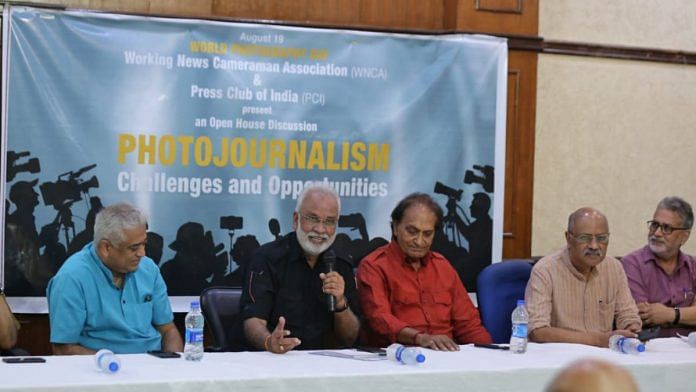New Delhi: On the occasion of World Photography Day Friday, the Working News Cameramen’s Association (WNCA) and the Press Club of India (PCI) jointly organised an open house discussion on photojournalism and the challenges around it.
There were 11 speakers at the session, including renowned photographer Raghu Rai, which was held in New Delhi.
S.N. Sinha, president of WNCA, moderated the discussion. Other panellists who were invited to the discussion were Shekhar Gupta, founder and editor-in-chief of ThePrint; Umakant Lakhera, president of PCI; senior journalist Rajdeep Sardesai; wildlife photographer Rajesh Bedi; Tanvi Mishra, a photo-editor; Ramdhani Dwivedi, news editor at Dainik Jagran; Saumya Khandelwal, a freelance photojournalist, Gurinder Osan, photo-editor at PTI; and Pallava Bagla, journalist and photographer.
Gupta, who was the keynote speaker, lamented the decline in the number of photojournalists today and stressed on the need for mentoring more individuals in the field. He also said it was everyone’s collective responsibility to mentor young journalists.
“Events like these have to be seen as moments of introspection. We can fret about the problems that photojournalists are facing, but perhaps mentoring is where the issue is. How come we never mentored a long line of successors who could be present in this room today?” he said.
Highlighting the importance of photojournalists, he said, “Camerapersons only have one moment or one microsecond. And in that, they make their own art.”
Sinha, meanwhile, compared photographs published in the newspapers earlier and today. “It’s not the equipment which clicks a photograph, it is the person. But these days, people do not want the individual to work. Today, everyone is a photographer,” he said.
Sinha also said the issue of restricting access to the media to cover certain events needed inspection. “The media is being stopped from covering major events. Just like the 15 August event at the Red Fort that took place only recently. This doesn’t just affect photographers, it affects readers too,” Sinha said.
Documenting history
Rai, a photographer who has been on the ground for most of his career, spoke about journalistic ethics. “Change the direction of your camera from the government, and try to explore the untouched spaces. In these big cities, why are we always just serving the big guys?” he said.
“There is a common saying that journalism is the first draft of history. But photojournalism is the evidence of that history being lived,” Rai added.
Lakhera, meanwhile, recalled a time when certain sections of the media industry labelled photojournalists as “second-class citizens” compared to reporters.
Also read: Arab Spring or Islamic winter? KP Fabian’s new ‘was and wasn’t’ book answers this question



